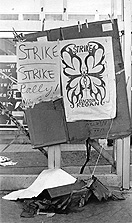Flashback
40 years ago
Campus unrest at UB
The annual ritual of spring break is eagerly anticipated by students and faculty alike, but it was UB administrators who were most grateful for the break in 1970. By 1969, cultural revolution and opposition to the war in Vietnam had led to unrest on college and university campuses. UB was no exception.
The university had been “torn asunder in violent dispute during a three-week period in 1970,” wrote Ann Whitcher-Gentzke in “A Stormy Spring” (UB Today, winter 2005). Whitcher-Gentzke based her narrative on a chronology created by Dean G. Pruitt, SUNY Distinguished Professor Emeritus in the Department of Psychology, as part of his research on campus unrest at UB, along with holdings in the University Archives and feedback from many alumni who responded to a call for firsthand accounts.
Pruitt begins his narrative for Feb. 26, 1970, with “The campus awakened with the realization that “Buffalo’s turn” had come.
There had been 16 arrests the preceding day after an angry mob of about 500 students protested in the Student Union. On Feb. 24, Buffalo police were called to a UB basketball game because of a demonstration connected with allegations of racism in the athletics department. In reaction, 40 to 50 students went to the office of Acting President Peter Regan the following day, demanding an explanation for the police presence. After rocks and ice were thrown at the windows of Regan’s office, campus police were called. About 500 students eventually assembled.
“At UB, student activism was fueled not only by continuing protests over the Vietnam War, but also by such local concerns as open admissions and the presence of Project Themis, a large research project that was controversial because it was funded by the U.S. Department of Defense,” wrote Whitcher-Gentzke.
The unrest escalated during the following days. A firebomb was thrown into Lockwood Library (now the South Campus’ Abbott Hall) on Feb. 26, destroying several hundred books.
The next day, a State Supreme Court judge issued a temporary restraining order “barring demonstrators from disrupting the university’s normal operations.” It was reissued on March 5.
In a television address on March 1, Regan described the group responsible for the violence as “vicious vandals.”
With only limited success, a strike committee of about 400 students tried to persuade professors to cancel classes and students to boycott those that were held. The strike committee blocked the entrance to Hayes Hall on March 5.
On March 8, the university administration asked Buffalo police to occupy the campus for an indeterminate stay. Later that day, nearly 2,000 students and faculty demonstrated against the police presence. Students staged a pig roast on March 10, and then on March 12, an angry confrontation resulted in 58 people being injured, including 35 police officers.
A group that would become known as the “Faculty 45” staged a sit-in in Hayes Hall on March 15 in hopes of moving the situation away from a cycle of violence between students and police. The group was arrested for violating the restraining order barring demonstrations.
By March 17, with spring break approaching, conditions improved and the violence waned. Police were asked to leave the campus later that month. However, Pruitt noted that “the rest of the semester was spent trying to restore unity on campus.”
The record of the research conducted by Pruitt is one of several collections in the University Archives documenting campus unrest at UB between 1963-1972. These collections contain personal recollections, official university documents, fact-finding reports, legal documents, photographs, newspaper clippings, posters and artifacts collected at the time or donated later, including one of the firebombs and, of course, copies of the 45 RPM recording “Hayes Hall Blues,” the local hit record written and produced after the arrest of the “Faculty 45.”
—John Edens, University Archives


Reader Comments